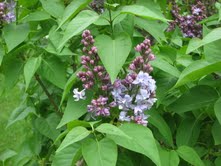Lilacs
Chris Wilson loves lilacs. He grows about 200 of them including more than 100 varieties at his home in West Newbury, Vermont. Like many gardeners, he was a little disappointed with the showing of his lilacs this year. There were fewer blossoms, and many were smaller than normal. I recently met with Chris, who works at E.C. Brown’s Nursery in Thetford Center, Vermont to discuss lilacs – and this year’s less than stellar performance.
First, Chris noted that many lilacs tend to follow two-year cycles of abundant bloom. Like apple trees that produce a heavy fruit load, producing a heavy crop of blossoms and seeds draws down on the energy of a lilac; the next year the lilacs tend to be less productive. I understand that phenomenon, but can’t imagine that all lilacs everywhere would be on the same cycle. But it does make me want to cut off the spent flower panicles on my favorite lilacs before they expend all the energy of making seeds.
The next possibility that Chris and I discussed was the extreme variations of temperature this spring. The early heat caused buds to swell and prepare for opening. That was followed by several hard frosts. Some of the buds may well have been damaged or made more susceptible to fungal diseases that have also attacked some lilacs this spring. He showed me some blackened stems and buds that were blighted and unproductive.
I have noticed that later-blooming lilacs are doing better than the earlier blooming lilacs did. That would make sense. Later blooming lilacs probably would not have buds that were ready to open during a week of high temperatures. Miss Kim, for example, is a very popular later-blooming lilac that is blooming quite well for me.
But my personal theory, unsubstantiated by any independent tests, is this: Last August was cool and rainy. I have read that lilacs set their spring buds in late summer, which I define as August- though the literature does not specify. I think that since lilacs got less sun than usual, they didn’t set as many buds. Then the hot/cold/hot weather this spring reduced even those numbers. And who knows what the lack of snow meant to lilacs. Gardening is full of unanswerable questions.
Conventional wisdom has it that lilacs need a top-dressing of ashes from the woodstove (or a dose of limestone from your local feed-n-grain store) each March. I disagree. Yes, lilacs do best in neutral or slightly sweet (alkaline) soil. For most of us, that means counteracting our acid rain by applying lime or wood ash once a year. But March? I think the timing has more to do with when farmers of past years were not too busy and had the time to spread some ashes. I believe that any time of year is just fine. It takes time for limestone to be incorporated into the soil. The key is to do it annually. I spread two quarts of wood ashes around a big lilac – whenever I get a chance. Do it now, before you forget. It really will make a difference next year.
Lilacs need annual pruning in order to look good. Most lilacs sucker, or send up new shoots from the roots. If you do not cut some of these back to the ground, the clump will get wider and wider. One way to keep your lilac vigorous is to remove a couple of the older stems each year, allowing the smaller and middle-sized stems to get larger. And unless you want to get on a ladder to cut blooms, you need to control height. Cut back tall stems to a fork, reducing height. The time to do it? Now, after the blossoms have finished.
It is often difficult to prune back stems to the ground as lilac stems grow very close to each other. But if you only cut back a stem to 2 or 3 feet above ground, you are left with stubs that are unsightly and that will sprout new shoots – often several new ones – that will clog up the center of the shrub more than the stem you cut off. My weapon of choice is a folding saw with a pointy end. I get on my knees and work the point into the clump as near the base as possible, and saw through a big stem. It takes time and energy, but is worth it.
After all the standard lilacs have finished blooming comes the show put on by Japanese tree lilacs. These are medium-sized trees, not shrubs. They have white flowers that are quite fragrant. But they may be invasive: the personnel at the Saint Gaudens National Historic Site in Cornish, NH, have found lots of young tree lilacs in the woods, and at the edge of the woods near their site. They have started pulling them as they decided that these visitors from the Far East have the potential to take over the understory. They are not, however, listed on any invasive species lists of prohibited plants.
The standard lilac is a wondrous plant. When I cross-country ski I sometimes see them by cellar holes of homes abandoned a century or more ago. Their flowers are beautiful and fragrant. What more could I we ask for?
Henry Homeyer is the author of 4 gardening books. His Web site is www.Gardening-guy.com.



